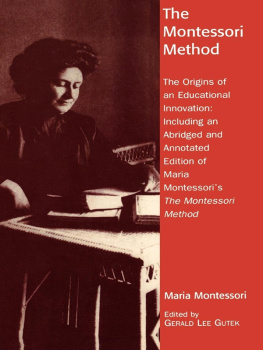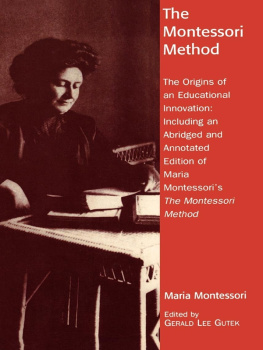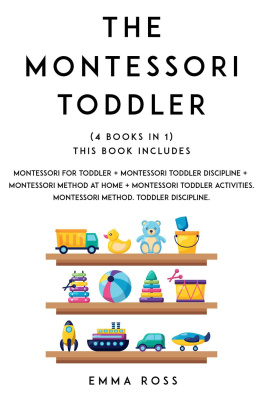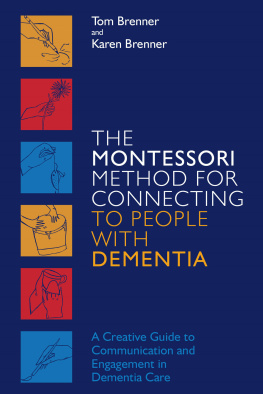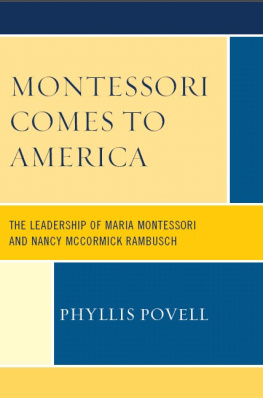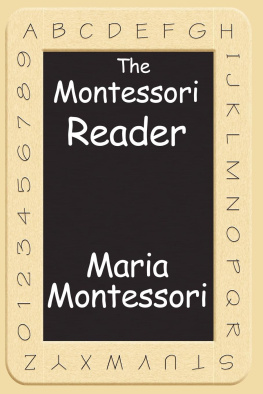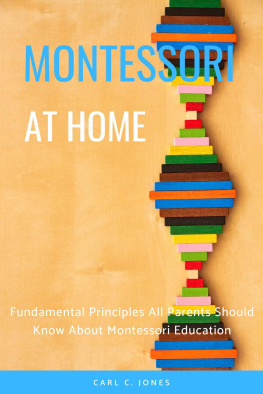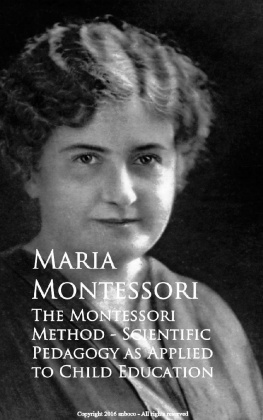Gerald Lee Gutek - The Montessori Method: The Origins of an Educational Innovation
Here you can read online Gerald Lee Gutek - The Montessori Method: The Origins of an Educational Innovation full text of the book (entire story) in english for free. Download pdf and epub, get meaning, cover and reviews about this ebook. year: 2013, publisher: Rowman & Littlefield Publishers, genre: Religion. Description of the work, (preface) as well as reviews are available. Best literature library LitArk.com created for fans of good reading and offers a wide selection of genres:
Romance novel
Science fiction
Adventure
Detective
Science
History
Home and family
Prose
Art
Politics
Computer
Non-fiction
Religion
Business
Children
Humor
Choose a favorite category and find really read worthwhile books. Enjoy immersion in the world of imagination, feel the emotions of the characters or learn something new for yourself, make an fascinating discovery.
- Book:The Montessori Method: The Origins of an Educational Innovation
- Author:
- Publisher:Rowman & Littlefield Publishers
- Genre:
- Year:2013
- Rating:4 / 5
- Favourites:Add to favourites
- Your mark:
- 80
- 1
- 2
- 3
- 4
- 5
The Montessori Method: The Origins of an Educational Innovation: summary, description and annotation
We offer to read an annotation, description, summary or preface (depends on what the author of the book "The Montessori Method: The Origins of an Educational Innovation" wrote himself). If you haven't found the necessary information about the book — write in the comments, we will try to find it.
The Montessori Method: The Origins of an Educational Innovation — read online for free the complete book (whole text) full work
Below is the text of the book, divided by pages. System saving the place of the last page read, allows you to conveniently read the book "The Montessori Method: The Origins of an Educational Innovation" online for free, without having to search again every time where you left off. Put a bookmark, and you can go to the page where you finished reading at any time.
Font size:
Interval:
Bookmark:
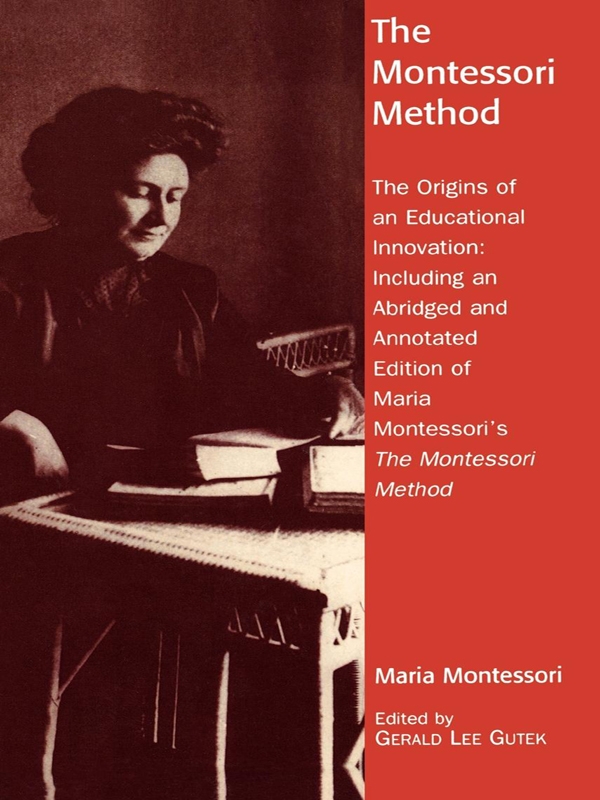
Anne E. George , an elementary teacher at the Chicago Latin School, visited the Casa dei Bambini in San Lorenzo in 1909 and had an interview with Maria Montessori. At the time, George did not know Italian and conversed with Montessori in French. When she returned to the United States, George brought with her a copy of Montessoris Il Metodo della Pedagogica Scientifica applicato alleducazione infantile nelle Case dei Bambine and some of Montessoris didactic materials. Committed to researching Montessoris method, George learned Italian so that she could read Montessoris book. She decided to go back to Rome and was the first American to enroll and complete the eight months training course that Montessori directed.
After completing the training course, George returned to the United States and established the first American Montessori school at Tarrytown, New York, in 1911. Leaving her assistant in charge of the Tarrytown school, George next established a Montessori school in Washington, D.C., in 1912 with the support of Alexander Graham Bell. Montessori held George in high esteem and regarded her as the only person qualified to implement her method in the United States. George was asked to translate Montessoris Il Methodo into an English version that was published by Frederick A. Stokes as The Montessori Method. The book quickly became a best-selling nonfiction work.
George became a member of the Montessori American Committee in 1912 that grew into the Montessori Educational Association. George, along with McClure, accompanied Montessori on her American speaking tour that the Association sponsored in 1913. George was acted as Montessoris translator for the lectures and press conferences that took place during the tour. Georges translation of the lectures emphasized the following Montessori themes: (1) The liberty of children to develop, without unnecessary adult interference, through self-active learning activities in a structured environment; (2) the use of didactic apparatus and materials in childrens auto-education; (3) examples of childrens interactions and discoveries in the prepared environment; (4) the difference between the Montessori directress and traditional teacher.
William Heard Kilpatrick (18711965) was a leading Pragmatist and Progressive educator. As a public school teacher in Georgia, he developed a highly child-centered and activity method of instruction. Rejecting competition and grades, he emphasized childrens whole cooperation in learning through group activities.
In 1912, Kilpatrick became a professor of education at Columbia Universitys Teachers College; he became a proponent of John Deweys Instrumentalist or Experimentalist Pragmatism. He identified with and was regarded as the leader of the progressive education wing of the Teachers College Faculty and associated with George S. Counts, John Childs, and Harold Rugg. Seeking to implement Deweys learning by the Complete Act of Thought into methods of instruction, Kilpatrick developed the project method, an activity-based approach in which pupils worked in groups to solve problems or pursue projects. Kilpatrick asserted that group-based education not only provided children with experience in implementing the scientific method but that it had concomitant learning consequences such as learning to share, to listen to others, and to practice democratic procedures. Kilpatrick, a popular and influential professor at Teachers College, was highly successful in promoting his Project Method. Project-based learning was a highly popular teaching method in the United States in the 1920s and 1930s.
Early in his professional career, Kilpatrick wrote two books in which he analyzed and criticized the educational ideas and methods of leading figures; The Montessori System Examined (1914) and Froebels Kindergarten Principles Critically Examined (1916). His critique of Montessori was based on an interview with her, visits to Montessori schools in Italy, and a detailed analysis of The Montessori Method , which had been published in English in 1912. The timing of Kilpatricks critique came at a key period for the first introduction of Montessori to the United States. Montessoris philosophy and method of education had attracted an enthusiastic following in the United States. Her lecture tour in 1913 had generated a favorable and well-publicized response from American audiences and journalists. Kilpatricks book had the effect of blunting the enthusiasm for Montessori, especially among professional educators, and of seriously weakening the Montessori movement.
In the excerpts from The Montessori System Examined , Kilpatrick claims that Montessoris educational generalizations are unscientific and her knowledge of education limited. He criticizes her concept of development, lack of group work, overreliance on mechanical didactic apparatus, and use of formal mental discipline in transfer of training. He finds Montessoris claims about childrens success in mastering practical life activities to be exaggerated. Kilpatrick concluded that Montessoris educational theory was a mid-nineteenth-century piece that was fifty years behind the times and much inferior to John Deweys philosophy of education.
Gerald Lee Gutek is professor emeritus at Loyola University. In 1989, he was the Loyola University of Chicago Outstanding Faculty Member. Among his books are A History of the Western Educational Experience (1995), Philosophical and Ideological Perspectives in Education (1997), American Education 1945-2000: A History and Commentary (2000), and Historical and Philosophical Foundations of Education: A Biographical Introduction (2000).
Montessori, Maria. The Absorbent Mind . New York: Henry Holt, 1995.
Montessori, Maria. The Advanced Montessori Method; Scientific Pedagogy as Applied to the Education of Children from Seven to Eleven Years, Volume I, Spontaneous Activity in Education . Oxford: Clio Press, 1991.
Montessori, Maria. The Advanced Montessori Method; Volume 2, Materials for Educating Elementary School Children . New York: Schocken Books, 1973.
Montessori, Maria, Paul Oswald, and Gunter Schulz-Benesch. Basic Ideas of Montessoris Educational Theory: Extracts from Maria Montessoris Writings and Teachings. Oxford: Clio Press, 1997.
Montessori, Maria, and Robert G. Buckenmeyer. The California Lectures of Maria Montessori: Collected Speeches and Writings. Oxford: Clio Press, 1997.
Montessori, Maria. The Child. Adyar, India: Theosophical Publish House, 1965.
Montessori, Maria, and E. M. Standing. The Child in the Church. St. Paul, Catechetical Guild, 1965.
Montessori, Maria. The Child in the Family. Oxford: Clio Press, 1989.
Montessori, Maria. The Child, Society and the World. Oxford: Clio Press, 1989.
Montessori, Maria. Child Training: Twelve Talks Broadcast from the Madras Station of All India Radio, June 112, 1948. Delphi: Publications Division, Ministry of Information and Broadcasting, 1948.
Montessori, Maria. Disciplining Children. Philadelphia: American Institute of Child Life, 1913.
Montessori, Maria. The Discovery of the Child. Oxford: Clio Press, 1988.
Montessori, Maria. Dr. Montessoris Own Handbook. New York: Schocken Books, 1965.
Montessori, Maria. Education and Peace. Oxford: Clio Press, 1992.
Montessori, Maria. Education for a Better World. U.S. American Institute for Psychological Research, 1990.
Montessori, Maria. Education for a New World. Oxford: Clio Press, 1989.
Montessori, Maria. Education in Relation to the Imagination of the Little Child. New York: The House of Childhood, Inc., 1915.
Font size:
Interval:
Bookmark:
Similar books «The Montessori Method: The Origins of an Educational Innovation»
Look at similar books to The Montessori Method: The Origins of an Educational Innovation. We have selected literature similar in name and meaning in the hope of providing readers with more options to find new, interesting, not yet read works.
Discussion, reviews of the book The Montessori Method: The Origins of an Educational Innovation and just readers' own opinions. Leave your comments, write what you think about the work, its meaning or the main characters. Specify what exactly you liked and what you didn't like, and why you think so.

